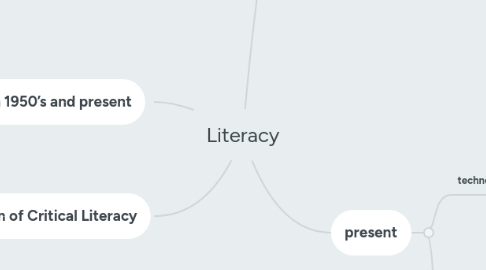
1. 1950's
1.1. technology not incorporated
1.1.1. Literacy seen as exclusively reading and writing
1.1.2. Orienting oneself
1.1.2.1. not able to orient oneself while reading until the end because there is no technology
1.2. comprehension
1.2.1. students look at texts in their own contexts and not situated in the contexts of other texts because they are not reading online
1.3. collaboration
1.3.1. Students collaborate solely face to face due to the fact that there is no internet or online databases
1.3.1.1. Students work together to form ideas that they wouldn't have figured out alone
2. present
2.1. technology incorporated
2.1.1. searching for information
2.1.1.1. Students in Miss Ramos' classroom experimented with effective searching
2.1.1.1.1. Activity 1: played a game where students used alternative words to describe what they were saying to show their understanding.
2.1.1.1.2. Activity 2: A game called Fetch. Students are put in pairs to research on dogs. Initially, students are only allowed to search one word. They see how many results come up when searching one word. As time goes on students are allowed to use more and more words to search about their topic. Each time they see how many articles come up and if it brings them to what they are reading about.
2.1.2. There are more demands on the reader to comprehend texts online
2.1.3. Comprehension
2.1.3.1. students look at multiple texts online to compare and comprehend what they are reading
2.1.4. Collaboration
2.1.4.1. Students can collaborate online to form ideas and understandings about a topic
2.1.4.1.1. Google Docs
2.1.5. Orienting oneself
2.1.5.1. Students read not just to get information but to also orient oneself about a topic and form opinions and make sense of a topic
2.1.5.1.1. With online reading, students can make sense and orient themselves about a topic sooner than print
2.2. Learning how visuals work
2.2.1. They provide more meaning about a text than simply just the words
2.2.2. read the visuals in conjunction with the text to provide more information about a topic
3. Both 1950’s and present
3.1. Texts are manipulated
3.1.1. People provide opinions
3.1.1.1. Need to be skeptical
3.1.1.1.1. Need to understand what are facts and what is opinion
3.1.2. Dangers of misinformation
3.2. Text and Online similarities
3.2.1. Hyperlinks for texts are seen as someone opening up an encyclopedia and going flipping to index to find additional information and then flight back to what they were additionally reading
4. Definition of Critical Literacy
4.1. “learning to read and write as part of the process of becoming conscious of one’s experience as historically constructed within specific power relations” (Anderson & Irvine, 1982) - found in "What is Critical Literacy in Education?'
4.1.1. Shift away from self to understanding the literacy in context
